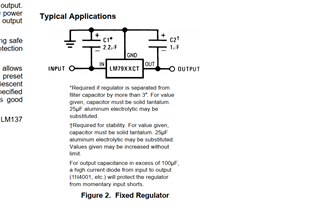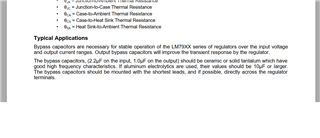大家好!
datasheet上对输入输出电容的选择有不同的说法。一个是选择钽电容,或者电解电容。另一个地方是说选择陶瓷电容或钽电容,或者10uf以上的电解电容。
我不知道该怎么选择了。我在之前的电路调试中,使用的是钽电容,但我几块板子都在上电过程中出现了钽电容损坏导致无法工作的情况,我只能换成了陶瓷电容。现在我要进行批量制板,但是datasheet上对电容的种类又有了前后不一致的描述,我想知道合适的处理方式到底是什么呢?
谢谢!
datasheet开头的描述:

datasheet中间的描述:

This thread has been locked.
If you have a related question, please click the "Ask a related question" button in the top right corner. The newly created question will be automatically linked to this question.
大家好!
datasheet上对输入输出电容的选择有不同的说法。一个是选择钽电容,或者电解电容。另一个地方是说选择陶瓷电容或钽电容,或者10uf以上的电解电容。
我不知道该怎么选择了。我在之前的电路调试中,使用的是钽电容,但我几块板子都在上电过程中出现了钽电容损坏导致无法工作的情况,我只能换成了陶瓷电容。现在我要进行批量制板,但是datasheet上对电容的种类又有了前后不一致的描述,我想知道合适的处理方式到底是什么呢?
谢谢!
datasheet开头的描述:

datasheet中间的描述:

Hi
见datasheet描述: The bypass capacitors, (2.2μF on the input, 1.0μF on the output) should be ceramic or solid tantalum which have good high frequency characteristics. If aluminum electrolytics are used, their values should be 10μF or larger. The bypass capacitors should be mounted with the shortest leads, and if possible, directly across the regulator terminals。
所以看你选择电容的材质。如你可以选择输入2.2uF, 输出1uF陶瓷电容。
其次一般电容差异,最多导致不稳定,不应该出现电容烧坏的问题。
Hi
除此之外,建议如果有条件的话,可以在显微镜上看一下电容是否有撞损的情况。